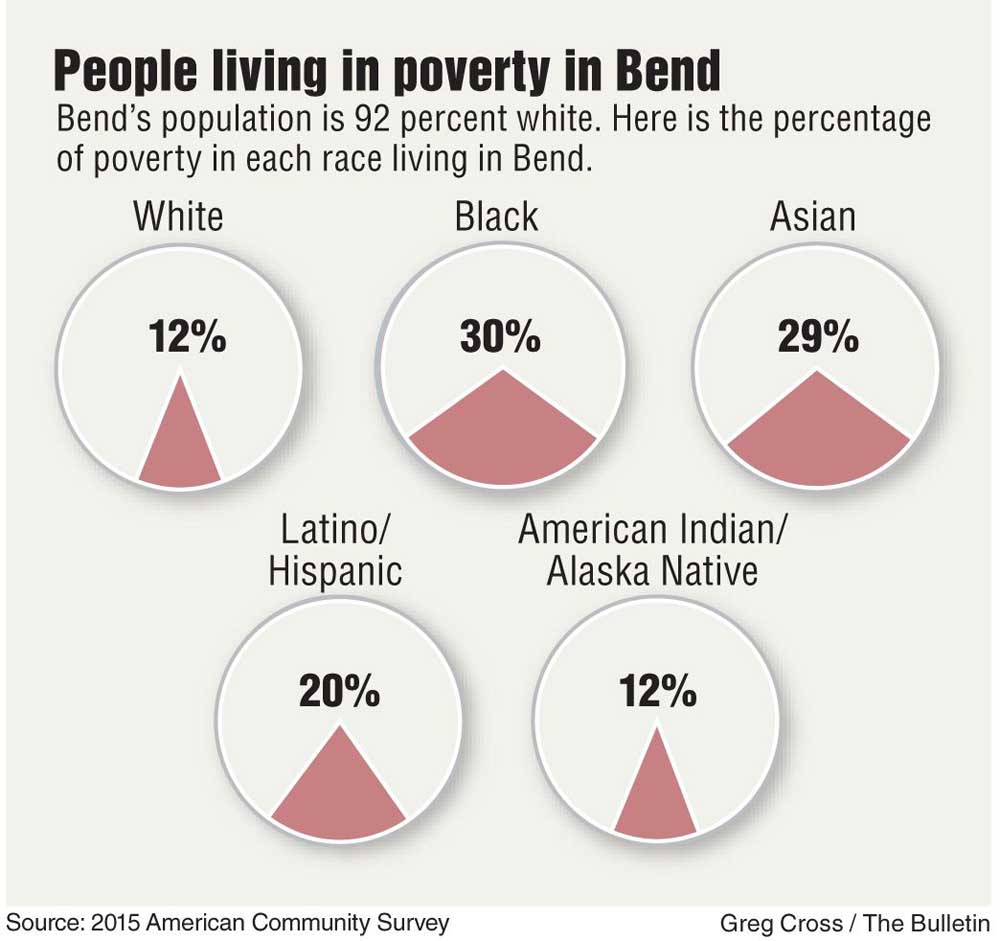Census finds minorities are more likely to live in poverty in Bend
Published 12:00 am Sunday, December 25, 2016

- Census finds minorities are more likely to live in poverty in Bend
Data from the U.S. Census Bureau’s 2015 American Community Survey shows racial minorities in Bend have noticeably higher rates of poverty.
For instance, 12 percent of Bend’s white residents lived in poverty in 2015, while the percentages of people living in poverty who are black, Asian or Latino were higher, sometimes nearly double that.
“That is horrific,” said Walidah Imarisha, a Portland-based writer and educator who has taught in Portland State University’s Black Studies Department. “But not surprising.”
Census data show the portion of Bend residents in poverty — regardless of race — rose from 5.7 percent to 14 percent between 2005 and 2015.
Experts and advocates say the gap between Bend’s cost of living and relatively low wages is impacting residents of all races but disproportionately affecting the city’s minority populations.
Minorities often experience discrimination when accessing housing, health care and schools, Imarisha said. Recently released census data show of all racial groups, black residents in Bend have the highest percentage of people living in poverty — about 30 percent, which is more than double the percentage of residents who are white.
Only 0.5 percent of Bend residents are black, according to the census data, but statewide data show a similar trend. The percentage of black Oregon residents living in poverty — about 33 percent — was more than double the percentage of white people living in poverty, according to census data.
“Institutions were never created to serve folks of color at all,” said Imarisha.
Imarisha, who’s also taught at Oregon State University, recently toured the state to lecture on the lack of diversity in Oregon.
Racism has been entrenched in the state for nearly two centuries when Oregon banned black people from living in its borders, she said.
The lack of diversity is still present in the state today. America’s population is 73 percent white, while Oregon’s population is 85 percent white, according to census data. Bend is 92 percent white.
Asians make up a mere 2 percent of Bend’s population, but nearly 29 percent of them live in poverty, according to census estimates. Meanwhile, Latinos make up 8 percent of the population, and 20 percent of Latinos live below the poverty level.
Statewide, 27 percent of Latinos lived in poverty, compared to 15 percent of white Oregon residents. However, the percentage of Asians living in poverty statewide — about 16 percent — was largely similar to the percentage of white people living in poverty.
Brad Porterfield, Central Oregon’s Latino Community Association executive director, said racial minorities who move to the region from other countries face barriers including language problems and low wages.
“Our economy depends on the immigrant workforce to fill a lot of the lower-income jobs, because they’re not the most enjoyable jobs,” said Porterfield.
Porterfield said many immigrants may come to the country with few English-language, writing and computer skills.
Many end up working low-paying jobs the Bend economy relies on — for instance, housekeeping in hotels, retail and farm labor, Portfield said.
“They just kind of assume right off the bat that they are relegated to the worst jobs,” he said.
Meanwhile, housing experts say regardless of race, Bend’s high cost of living is driving more and more people into poverty. Census data show the median rent cost in Bend grew 9 percent from 2010 to 2015, yet median income has remained largely stagnant.
“The cost of living is so out of reach for folks,” said Cody Standiford, community liaison for Central Oregon Veterans Outreach.
“That wage gap just keeps getting wider and wider and wider.”
— Reporter: 541-633-2160, mriker@bendbulletin.com






